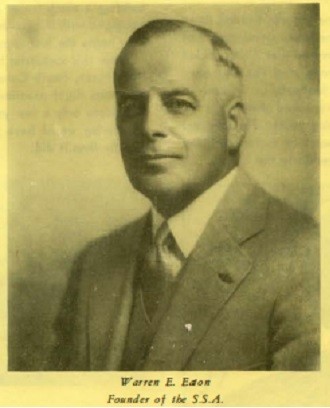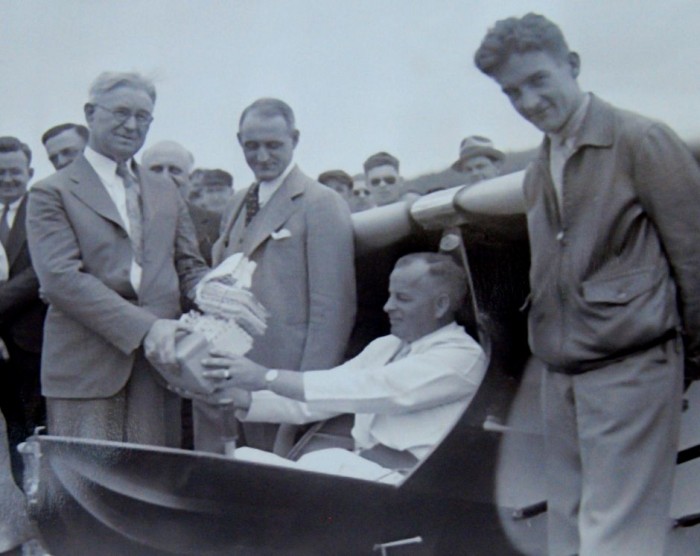Warren E. Eaton
1954
about
(1888-1934) SSA Co-Founder; First SSA President
Bio
Warren Eaton was born into a prominent Norwich, NY family. He graduated from Norwich High School in 1907 and enrolled part-time at the Wharton School of Finance. For reasons unknown, Warren left Wharton a year earlier than planned, and returned to Norwich in June 1910 to begin working in his father's successful grain and feed business.
Warren flew a SPAD XIII with the 103rd Aero Squadron, 3rd Pursuit Group in late WW I, where he downed one, possibly two, German planes for which he was awarded the Distinguished Service Cross (second only to the Medal of Honor). In the 1920s, Eaton opened a flying school for airplanes (and later, gliders) on Hall Flying Field in Norwich. This airport was subsequently re-named the Lt. Warren E. Eaton Airport.

Eaton was a major organizational figure in the first five (1930-4) National Glider meets in nearby Elmira. He won the Altitude prize in 1930 and made the first aero tow from what we now call Harris Hill. He was part of the first triple and quadruple glider tows, the first to fly glider airmail during a contest, and the first to radio broadcast from a glider to a crowd below. In the early '30s, Eaton was the most active promoter of gliding and soaring in the U.S. In 1932, Eaton led the formation of the Soaring Society of America and was elected its first president. He served three years during which he covered much of the young SSA's expenses.
In September, 1934, Dick du Pont (U.S. HoF, 1954) and Eaton made exploratory ridge flights in the Appalachians. Eaton flew his high-performance Bowlus-du Pont Senior Albatross, which he had named "Falcon". At Big Meadows, Virginia, Eaton set a new American soaring altitude record of 9,094 feet.
Listen to Warren speaking on the 5th National Soaring Contest in July 1934 (8.1MB; MP3)
Also in 1934, Eaton visited glider youth camps in Nazi Germany. Perhaps sensing what might be coming, he advocated before Congress for a much-expanded SSA, to include glider flight training in college ROTC programs, especially at Annapolis and West Point. Unfortunately, Eaton's untimely passing only weeks later left nobody to champion this idea.
On December 1, 1934, Eaton fell to his death from a double tow over Miami's Biscayne Bay. The tow was for publicity photos to promote the winter glider school Eaton was ready to open. His custom aerobatic Franklin PS-2 landed itself with almost no damage; recently restored, it is now on permanent display at the National Soaring Museum.
In 1935, Warren Eaton's widow, Genevieve, donated Eaton's "Falcon" to the Smithsonian Institution; it was promptly hung in "The Castle" in Washington where it remained on display for many years. "Falcon" currently soars high in the Udvar-Hazy Center, the Smithsonian's National Air and Space Museum annex at Dulles International.
In 1937, SSA named the complex of glider buildings on Harris Hill the Warren E. Eaton Motorless Flight Facilities. After Eaton's death, Mrs. Eaton served in his place on the SSA Board of Directors. Hoping to inspire new American gliders, she sponsored the Eaton Design Contest in 1937. In 1939 SSA established the Warren E. Eaton Memorial Trophy to be awarded each year to a person who has made an outstanding contribution to the art, sport, or science of soaring flight in the United States. It is defined as SSA's highest award. The Eaton Memorial silver trophy was presented to SSA by Mrs. Eaton.
In 1954 Eaton was inducted in the inaugural class of the United States Soaring Hall of Fame. Warren Eaton was the George Washington of American soaring.

by Jack Wyman - restorer of the glider in which Eaton lost his life.